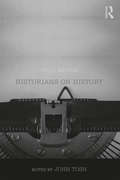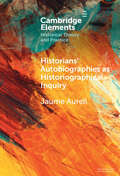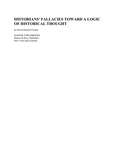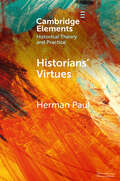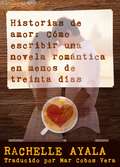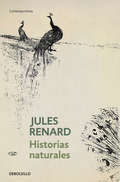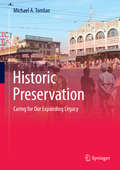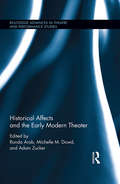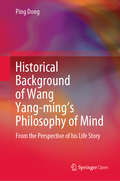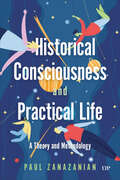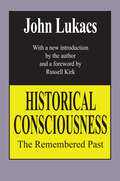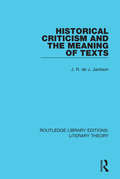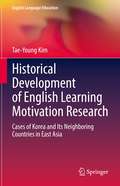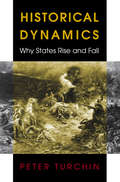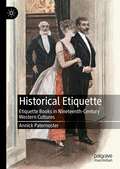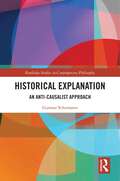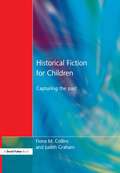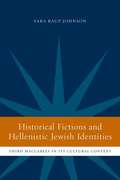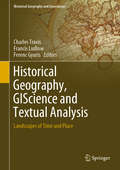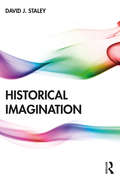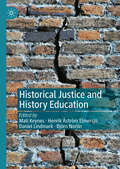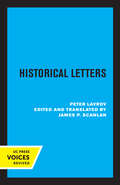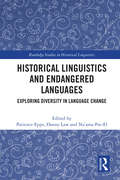- Table View
- List View
Historians on History
by John ToshBringing together in one volume the key writings of many of the major historians from the last few decades, Historians on History provides an overview of the evolving nature of historical enquiry, illuminating the political, social and personal assumptions that have governed and sustained historical theory and practice. John Tosh’s Reader begins with a substantial introductory survey charting the course of historiographical developments since the second half of the nineteenth century. He explores both the academic mainstream and more radical voices within the discipline. The text is composed of readings by historians such as Braudel, Carr, Elton, Guha, Hobsbawm, Scott and Jordanova. This third edition has been brought up to date by taking the 1960s as its starting point. It now includes more recent topics like public history, microhistory and global history, in addition to established fields like Marxist history, gender history and postcolonialism. Historians on History is essential reading for all students of historiography and historical theory.
Historians' Autobiographies as Historiographical Inquiry: A Global Perspective (Elements in Historical Theory and Practice)
by Jaume AurellThis Element analyses the autobiographies of historians from a global perspective and looks at all eras, from antiquity to the present day. It includes twenty autobiographies: Caesar's and Lucian of Samosata's memories in antiquity; an autobiography of a medieval king such as Peter IV of Aragon; Vico's, Gibbon's and Adams' intellectual self-accounting in modernity; autobiographical revelations and social activism of twentieth century women historians such as Carolyn Steedman, Jill Conway and Gerda Lerner; classical Chinese and Islamic traditions through the autobiographies of Sima Quian and Ibn Khaldun; the perplexities inherent in the modernisation of Japan (Fukuzawa Yukichi), China (Gu Jiegang), India (Nirad Chaudhuri) and Egypt (Taha Hussein); postmodernists such as Rosenstone; and traumatic postcolonial experiences in Africa (Bethwell Ogot), Latin America (Carlos Eire) and Southeast Asia (Wang Gungwu). This Element proposes a literary and historical approach to these autobiographies, emphasising its historiographical dimension and value.
Historians' Fallacie: Toward a Logic of Historical Thought
by David Hackett Fischer"If one laughs when David Hackett Fischer sits down to play, one will stay to cheer. His book must be read three times: the first in anger, the second in laughter, the third in respect....The wisdom is expressed with a certain ruthlessness. Scarcely a major historian escapes unscathed. Ten thousand members of the American Historical Association will rush to the index and breathe a little easier to find their names absent.
Historians' Virtues: From Antiquity to the Twenty-First Century (Elements in Historical Theory and Practice)
by Herman PaulWhy do historians so often talk about objectivity, empathy, and fair-mindedness? What roles do such personal qualities play in historical studies? And why does it make sense to call them virtues rather than skills or habits? Historians' Virtues is the first publication to explore these questions in some depth. With case studies from across the centuries, the Element identifies major discontinuities in how and why historians talked about the marks of a good scholar. At the same time, it draws attention to long-term legacies that last until today. Virtues were, and are, invoked in debates over the historian's task. They reveal how historians position themselves vis-à-vis political regimes, religious traditions, or neoliberal university systems. More importantly, they show that historical study not only requires knowledge and technical skills, but also makes demands on the character of its practitioners. This title is also available as Open Access on Cambridge Core.
Historias de amor: Cómo escribir una novela romántica en menos de treinta días
by Rachelle AyalaEste libro os enseña a escribir una novela corta romántica efectiva y cautivadora en muy pocas semana. Descubrid los siete pilares que debe tener cualquier novela, la diferencia entre la novela corta y la novela propiamente dicha y cómo condensar la línea argumental para tener un resultado óptimo. Incluye un método paso a paso, una programación de tareas, trucos, así como aspectos a evitar. Os ayudará a elaborar historias de calidad entretenidas que gustarán a vuestras lectoras y servirán para impulsar vuestra carrera.
Historias naturales
by Jules RenardLas Historias naturales son fragmentos de ese paraíso roto. Como un cazador de imágenes, el autor observa con detenimiento antes de esbozar estos retratos breves, impregnados de humor y profundo lirismo, que configuran una suerte de bestiario medieval. Su fijación por la búsqueda de la frase mínima y la palabra exacta da como resultado estas estampas naturales, que inspiraron una bella composición musical de Maurice Ravel y que son, como el resto de su obra, lúcidas reflexiones sobre su tiempo.La presente versión parte de la edición de 1909, última publicada en vida del autor, ilustrada con veintidós litografías de Henri de Toulouse-Lautrec.«Renard conserva, sí, esa fuerza motriz de la gran escritura, que tensa y destensa los músculos faciales del lector, dilata o contrae sus pupilas, y de vez en cuando, con una súbita determinación, con un quiebro imprevisible, relampagueante, provoca un estremecimiento que recorre las vértebras.»Manuel Rivas
Historic Preservation
by Michael A. TomlanThis well-illustrated book offers an up-to-date synthesis of the field of historic preservation, cast as a social campaign concerned with the condition, treatment and use of the legacy of existing properties in the United States. Drawing on a wide range of research, experience and scholarship over the last fifty years, it allows us to re-think past and current ideas in preservation, challenging readers to explore how their own interests lie within the cognitive framework of the activities taking place with people who care. "Who" is involved is explored first, in such a way as to explore "why", before examining "what" is deemed important. After that the questions of "when" and "how" to proceed are given attention. The major topics are introduced in an historical review through the mid-1980s, after which the broad intellectual basis and fundamental legal framework is provided. The economic shifts associated with major demographic changes are explored, in tandem with responses of the preservation community. A chapter is dedicated to the financial challenges and sources of revenue available in typical preservation projects, and another chapter focuses on the manner in which seeing, recording, and interpreting information provides the context for an appropriate vision for the future. In this regard, it is made clear that not all "green" design alternatives are preservation-sensitive. The advocacy battles during the last few decades provide a number of short stories of the ethical battles regarding below-ground and above ground historic resources, and the eighth chapter attempts to explain why religion has been long held at arm's length in publicly-supported preservation efforts, when in fact, it holds more potential to regenerate existing sites than any governmental program.
Historical Affects and the Early Modern Theater (Routledge Advances in Theatre & Performance Studies)
by Ronda Arab Michelle Dowd Adam ZuckerThis collection of original essays honors the groundbreaking scholarship of Jean E. Howard by exploring cultural and economic constructions of affect in the early modern theater. While historicist and materialist inquiry has dominated early modern theater studies in recent years, the historically specific dimensions of affect and emotion remain underexplored. This volume brings together these lines of inquiry for the first time, exploring the critical turn to affect in literary studies from a historicist perspective to demonstrate how the early modern theater showcased the productive interconnections between historical contingencies and affective attachments. Considering well-known plays such as Shakespeare’s Antony and Cleopatra and Thomas Dekker’s The Shoemaker’s Holiday together with understudied texts such as court entertainments, and examining topics ranging from dramatic celebrity to women’s political agency to the parental emotion of grief, this volume provides a fresh and at times provocative assessment of the "historical affects"—financial, emotional, and socio-political—that transformed Renaissance theater. Instead of treating history and affect as mutually exclusive theoretical or philosophical contexts, the essays in this volume ask readers to consider how drama emplaces the most personal, unspeakable passions in matrices defined in part by financial exchange, by erotic desire, by gender, by the material body, and by theatricality itself. As it encourages this conversation to take place, the collection provides scholars and students alike with a series of new perspectives, not only on the plays, emotions, and histories discussed in its pages, but also on broader shifts and pressures animating literary studies today.
Historical Background of Wang Yang-ming’s Philosophy of Mind: From the Perspective of his Life Story
by Ping DongThis open access book offers comprehensive information on Wang Yang-ming’s life, helping readers identify and grasp the foundations on which his philosophy was established. Though a great man, Wang had an extremely difficult life, full of many hardships. Based on various official histories, Wang’s own writings, and his disciples’ records, the book explores the legendary life of this ancient philosopher, who not only diligently pursued his objective of living as a sage, but also persistently sought the ideal state of a sage in ideology. The author also shares his own interpretations of the main aspects of Wang’s philosophy using simple and straightforward language.This book will help readers understand and appreciate Wang Yang-ming’s extraordinary life, his generous mind, deep thoughts and bright personality, inspiring them to pursue enriching lives. It offers a unique and insightful work for undergraduate students and all others interested in Wang’s philosophy and life story.
Historical Consciousness and Practical Life: A Theory and Methodology
by Paul ZanazanianHistorical Consciousness and Practical Life introduces a novel approach to examining how people construct and employ historical knowledge in their daily lives. In viewing history as an embodied cultural practice that constitutes the background to our meaning-making, the book demonstrates how researchers and others can investigate the ways in which people make sense of time’s flow in their now-moment engagements with the world and use that information to position themselves regarding key social problems with historical roots. The book provides a glimpse at how humans enter historically embedded thinking problems, seeking to resolve them. Paul Zanazanian draws on a study of the community leaders of English-speaking Quebec to illustrate the practical life methodology’s workings. In looking at their different uses of history for strengthening their group’s vitality in the province, he identifies five key stances these leaders employ for positioning their sense of purpose and responsibility for securing English-speaking Quebec’s future. Ultimately, Historical Consciousness and Practical Life argues that community leaders who complicate and problematize their uses of history are the best positioned to make positive transformations for their group.
Historical Consciousness: The Remembered Past
by John LukacsOne of the most important developments of Western civilization has been the growth of historical consciousness. Consciously or not, history has become a form of thought applied to every facet of human experience; every field of human action can be studied, described, or understood through its history. In this extraordinary analysis of the meaning of the remembered past, John Lukacs discusses the evolution of historical consciousness since its first emergence about three centuries ago.
Historical Criticism and the Meaning of Texts (Routledge Library Editions: Literary Theory #17)
by J. R. JacksonIn this original and significant contribution to literary controversy, first published in 1989, Professor Jackson argues on semantic grounds that historical criticism, which he defines as the attempt to read works of literature and criticism as they were read when they were new, is a necessary preliminary to other ways of approaching the literature of the past. He distinguishes between the difficulties inherent in the practice of historical critics and the problems encountered by historians. Historical criticism as he describes it is an ideal that has yet to be attained and he explores strategies for coming closer to it. This title will be of interest to students of literature.
Historical Criticism and the Meaning of Texts (Routledge Library Editions: Literary Theory)
by J. R. JacksonIn this original and significant contribution to literary controversy, first published in 1989, Professor Jackson argues on semantic grounds that historical criticism, which he defines as the attempt to read works of literature and criticism as they were read when they were new, is a necessary preliminary to other ways of approaching the literature of the past. He distinguishes between the difficulties inherent in the practice of historical critics and the problems encountered by historians. Historical criticism as he describes it is an ideal that has yet to be attained and he explores strategies for coming closer to it. This title will be of interest to students of literature.
Historical Development of English Learning Motivation Research: Cases of Korea and Its Neighboring Countries in East Asia (English Language Education #21)
by Tae-Young KimThis book clarifies the fundamental difference between North America-based instrumental motivation and Korea (and East Asia)-specific competitive motivation by which the EFL learners’ excessive competition to be admitted to famous universities and to be hired at a large-scale conglomerate is the main source of L2 motivation. It enables readers to understand that EFL-learning motivation reflects unique sociohistorical contexts grounded in a specific region or country. This book in turn necessitates the need to develop EFL motivation theory and research tradition which are firmly based on East Asian values and culture.
Historical Dynamics: Why States Rise and Fall (Princeton Studies in Complexity #26)
by Peter TurchinMany historical processes are dynamic. Populations grow and decline. Empires expand and collapse. Religions spread and wither. Natural scientists have made great strides in understanding dynamical processes in the physical and biological worlds using a synthetic approach that combines mathematical modeling with statistical analyses. Taking up the problem of territorial dynamics--why some polities at certain times expand and at other times contract--this book shows that a similar research program can advance our understanding of dynamical processes in history. Peter Turchin develops hypotheses from a wide range of social, political, economic, and demographic factors: geopolitics, factors affecting collective solidarity, dynamics of ethnic assimilation/religious conversion, and the interaction between population dynamics and sociopolitical stability. He then translates these into a spectrum of mathematical models, investigates the dynamics predicted by the models, and contrasts model predictions with empirical patterns. Turchin's highly instructive empirical tests demonstrate that certain models predict empirical patterns with a very high degree of accuracy. For instance, one model accounts for the recurrent waves of state breakdown in medieval and early modern Europe. And historical data confirm that ethno-nationalist solidarity produces an aggressively expansive state under certain conditions (such as in locations where imperial frontiers coincide with religious divides). The strength of Turchin's results suggests that the synthetic approach he advocates can significantly improve our understanding of historical dynamics.
Historical Etiquette: Etiquette Books in Nineteenth-Century Western Cultures
by Annick PaternosterThis book is a groundbreaking study of etiquette in the nineteenth century when the success of etiquette books reached unprecedented heights in Britain, France, Italy, the Netherlands, and the United States. It positions etiquette as a fully-fledged theoretical concept within the fields of politeness studies and historical pragmatics. After tracing the origin of etiquette back to Spanish court protocol, the analysis takes a novel approach to key aspects of etiquette: its highly coercive and intricate scripts; the liminal rituals of social gatekeeping; the fear for blunders; the obsession with precedence. Interrogating the complex relationship between historical etiquette and adjacent notions of politeness, conduct, morality, convention, and ritual, the study prompts questions on gender stereotyping and class privilege surrounding the present-day etiquette revival. Through adopting a unique comparative approach and a corpus-based methodology this study seeks to revitalise our understandings of etiquette. This book will be of interest to scholars of historical linguistics and pragmatics, as well as those in neighbouring fields such as literary criticism, gender studies and family life, domestic and urban spaces.
Historical Explanation: An Anti-Causalist Approach (Routledge Studies in Contemporary Philosophy)
by Gunnar SchumannThis book is concerned with the appropriate form of explanations in historiography and the social sciences. It combines action theory and philosophy of historiography and develops a theory of teleological explanations of human actions based on late-Wittgensteinian and Ordinary Language Philosophy insights. In philosophy of action, many philosophers favor causal theories of human action. Additionally, in current philosophy of historiography the majority view is that historians should explain historical phenomena by their causes. This book pushes back against these mainstream views by reviving an anti-causal view of explanation of current and past human actions. The author argues that disciplines that deal with human actions require a certain form of explanation, namely a teleological or intentional explanation. This means that past human actions and their results will have to be explained by reasons of agents, not by causes. Therefore, historiography employs a method of explanation which is in stark contrast to the sciences. The author thus proposes a Verstehen (understanding) approach in historiography and the social sciences. Historical Explanation will be of interest to scholars and advanced students working in philosophy of action, philosophy of history, and philosophy of the social sciences.
Historical Fiction for Children: Capturing the Past
by Judith Graham Fiona M. CollinsHistorical fiction has a great deal to offer as its readers and devotees have always known. The time is ripe however for the historical novel and historical picture book to be promoted more emphatically so that many more are made aware of the delight and learning to be found in the genre. The editors of this book invited authors, academic writers and teachers to reflect on the nature, scope, range and richness of historical fiction for children. What is collected here provides an overview of the field, a consideration of significant writers of historical fiction from the nineteenth century onwards, a sense of the various historical eras commonly explored (Stone Age to World War 2), a discussion of commonly raised issues, themes and topics such as child labor, slavery and migration, and a forum for writers to reveal their insights into the writing of historical fiction. Julian Atterton, Berlie Doherty, Michael Foreman and Philip Pullman have made contributions. It provides evidence of children and students engaging creatively with historical fiction.
Historical Fictions and Hellenistic Jewish Identity: Third Maccabees in Its Cultural Context
by Sara Raup JohnsonThis book investigates the creation of historical fictions in a wide range of Hellenistic Jewish texts. Surveying Jewish novels, she demonstrates that the use of historical fiction in these texts does not constitute a uniform genre. Instead it cuts across all boundaries of language, provenance, genre, and even purpose.
Historical Geography, GIScience and Textual Analysis: Landscapes of Time and Place (Historical Geography and Geosciences)
by Ferenc Gyuris Charles Travis Francis LudlowThis book illustrates how literature, history and geographical analysis complement and enrich each other’s disciplinary endeavors. The Hun-Lenox Globe, constructed in 1510, contains the Latin phrase 'Hic sunt dracones' ('Here be dragons'), warning sailors of the dangers of drifting into uncharted waters. Nearly half a millennium earlier, the practice of ‘earth-writing’ (geographia) emerged from the cloisters of the great library of Alexandria, as a discipline blending the twin pursuits of Strabo’s poetic impression of places, and Herodotus’ chronicles of events and cultures. Eratosthenes, a librarian at Alexandria, and the mathematician Ptolemy employed geometry as another language with which to pursue ‘earth-writing’. From this ancient, East Mediterranean fount, the streams of literary perception, historical record and geographical analysis (phenomenological and Euclidean) found confluence. The aim of this collection is to recover such means and seek the fount of such rich waters, by exploring relations between historical geography, geographic information science (GIS) / geoscience, and textual analysis. The book discusses and illustrates current case studies, trends and discourses in European, American and Asian spheres, where historical geography is practiced in concert with human and physical applications of GIS (and the broader geosciences) and the analysis of text - broadly conceived as archival, literary, historical, cultural, climatic, scientific, digital, cinematic and media. Time as a multi-scaled concept (again, broadly conceived) is the pivot around which the interdisciplinary contributions to this volume revolve. In The Landscape of Time (2002) the historian John Lewis Gaddis posits: “What if we were to think of history as a kind of mapping?” He links the ancient practice of mapmaking with the three-part conception of time (past, present, and future). Gaddis presents the practices of cartography and historical narrative as attempts to manage infinitely complex subjects by imposing abstract grids to frame the phenomena being examined— longitude and latitude to frame landscapes and, occidental and oriental temporal scales to frame timescapes. Gaddis contends that if the past is a landscape and history is the way we represent it, then it follows that pattern recognition constitutes a primary form of human perception, one that can be parsed empirically, statistically and phenomenologically. In turn, this volume reasons that literary, historical, cartographical, scientific, mathematical, and counterfactual narratives create their own spatio-temporal frames of reference. Confluences between the poetic and the positivistic; the empirical and the impressionistic; the epic and the episodic; and the chronologic and the chorologic, can be identified and studied by integrating practices in historical geography, GIScience / geoscience and textual analysis. As a result, new perceptions and insights, facilitating further avenues of scholarship into uncharted waters emerge. The various ways in which geographical, historical and textual perspectives are hermeneutically woven together in this volume illuminates the different methods with which to explore terrae incognitaes of knowledge beyond the shores of their own separate disciplinary islands.
Historical Imagination
by David J. StaleyHistorical Imagination examines the threshold between what historians consider to be proper, imagination-free history and the malpractice of excessive imagination, asking where the boundary between the two sits and the limits of permitted imagination for the historian. We use "imagination" to refer to a mental skill that encompasses two different tasks: the reconstruction of previously experienced parts of the world and the creation of new objects and experiences with no direct connection to the actual world. In history, imagination means using the mind's eye to picture both the actual and inactual at the same time. All historical works employ at least some creative imagination, but an excess is considered "too much". Under what circumstances are historians permitted to cross this boundary into creative imagination and how far can they go? Supporting theory with relatable examples, Staley shows how historical works are a complex combination of mimetic and creative imagination and offers a heuristic for assessing this ratio in any work of history. Setting out complex theoretical concepts in an accessible and understandable manner and encouraging the reader to consider both the nature and limits of historical imagination, this is an ideal volume for students and scholars of the philosophy of history.
Historical Justice and History Education
by Henrik Åström Elmersjö Daniel Lindmark Björn Norlin Mati KeynesThis book explores how the expectations of historical justice movements and processes are understood within educational contexts, particularly history education. In recent years, movements for historical justice have gained global momentum and prominence as the focus on righting wrongs from the past has become a feature of contemporary politics. This imperative has manifested in globally diverse contexts including societies emerging from recent, violent conflict, but also established democracies which are increasingly compelled to address the legacies of colonialism, slavery, genocides, and war crimes, as well as other forms of protracted discord. This book examines historical justice from an educational perspective, exploring the myriad ways that education is understood as a site of historical injustice, as well as a mechanism for redress. The editors and contributors analyse the role of history education in processes of historical justice broadly, exploring educational sites, policies, media, and materials. This edited collection is a unique and important touchstone volume for scholars, policy-makers, practitioners, and teachers that can guide future research, policy, and practice in the fields of historical justice, human rights and history education.
Historical Letters: Peter Lavrov
by Peter LavrovThis title is part of UC Press's Voices Revived program, which commemorates University of California Press’s mission to seek out and cultivate the brightest minds and give them voice, reach, and impact. Drawing on a backlist dating to 1893, Voices Revived makes high-quality, peer-reviewed scholarship accessible once again using print-on-demand technology. This title was originally published in 1967.
Historical Linguistics
by Don Ringe Joseph F. EskaBringing the advances of theoretical linguistics to the study of language change in a systematic way, this innovative textbook demonstrates the mutual relevance of historical linguistics and contemporary linguistics. Numerous case studies throughout the book show both that theoretical linguistics can be used to solve problems where traditional approaches to historical linguistics have failed to produce satisfying results, and that the results of historical research can have an impact on theory. The book first explains the nature of human language and the sources of language change in broad terms. It then focuses on different types of language change from contemporary viewpoints, before exploring comparative reconstruction - the most spectacular success of traditional historical linguistics -and the problems inherent in trying to devise new methods for linguistic comparison. Positioned at the cutting edge of the field, the book argues that this approach can and should lead to the re-integration of historical linguistics as one of the core areas in the study of language.
Historical Linguistics and Endangered Languages: Exploring Diversity in Language Change (Routledge Studies in Historical Linguistics)
by Patience EppsThis collection showcases the contributions of the study of endangered and understudied languages to historical linguistic analysis, and the broader relevance of diachronic approaches toward developing better informed approaches to language documentation and description. The volume brings together perspectives from both established and up-and-coming scholars and represents a globally and linguistically diverse range of languages.The collected papers demonstrate the ways in which endangered languages can challenge existing models of language change based on more commonly studied languages, and can generate innovative insights into linguistic phenomena such as pathways of grammaticalization, forms and dynamics of contact-driven change, and the diachronic relationship between lexical and grammatical categories. In so doing, the book highlights the idea that processes and outcomes of language change long held to be universally relevant may be more sensitive to cultural and typological variability than previously assumed. Taken as a whole, this collection brings together perspectives from language documentation and historical linguistics to point the way forward for richer understandings of both language change and documentary-descriptive approaches, making this key reading for scholars in these fields.
